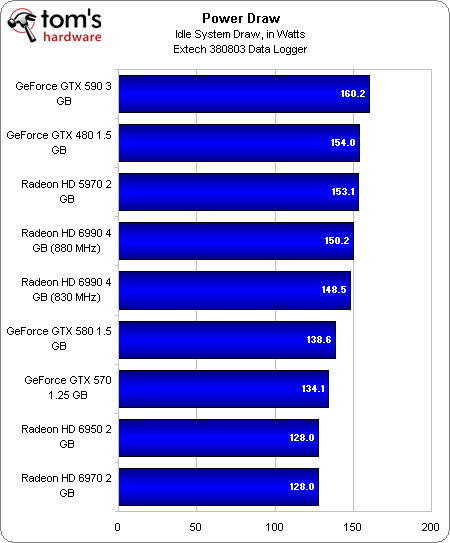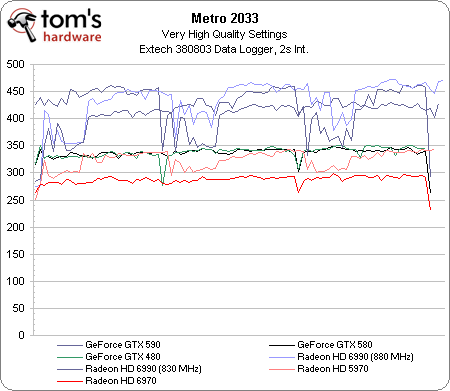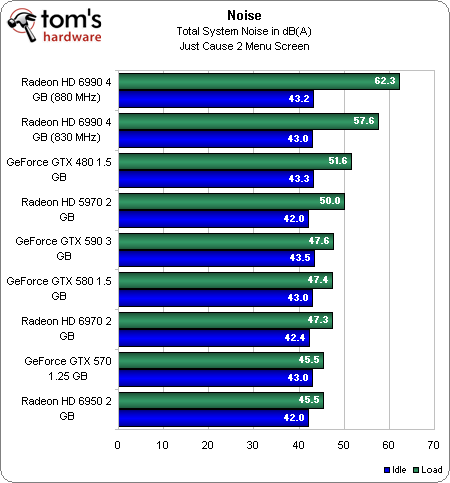Nvidia GeForce GTX 590 3 GB Review: Firing Back With 1024 CUDA Cores
AMD shot for—and successfully achieved—the coveted “fastest graphics card in the world” title with its Radeon HD 6990. Now, Nvidia is gunning for that freshly-claimed honor with a dual-GF110-powered board that speaks softly and carries a big stick.
Power, Noise, And Air Temperatures

I don’t think this one will surprise anyone. At idle, the GeForce GTX 590 draws more power than any other graphics card in our comparison, taking that un-honor away from the GeForce GTX 480.
It’s probably fair to say that enthusiasts spending $700 on graphics aren’t really concerned by the 32 W spread between Nvidia’s new flagship and the lowest-power option in this chart, though. Let’s see if the situation gets any direr under load.

Nvidia’s GF110 is a more power-hungry GPU than AMD’s Cayman. However, Nvidia still faces very real limits with two graphics processors on a PCB. Those constraints force the company to drop the clocks on GeForce GTX 590 in a significant way. The result is a power consumption chart that looks very much like AMD’s overclocked, voided-warranty Radeon HD 6990 at 880 MHz.
The obvious discrepancy there is that AMD rates that particular configuration for 450 W, while Nvidia says the GeForce GTX 590 is a 365 W board. Average out those lines, and you’ll see the following system power use:
| Header Cell - Column 0 | Average Power Consumption (Metro 2033, Three Runs) |
|---|---|
| Nvidia GeForce GTX 590 | 437.18 W |
| Nvidia GeForce GTX 580 | 337.47 W |
| Nvidia GeForce GTX 480 | 338.34 W |
| AMD Radeon HD 6990 (880 MHz) | 432.17 W |
| AMD Radeon HD 6990 (830 MHz) | 396.21 W |
| AMD Radeon HD 5970 | 323.43 W |
| AMD Radeon HD 6970 | 287.26 W |
The GeForce GTX 590 is actually more power-hungry than the overclocked Radeon HD 6990. It also makes the GeForce GTX 480 look like an econobox, which of course it’s not.
From a power bill-perspective, that’s scary stuff. But again, you probably don’t care, right? It’s a difference of 5 W up against the Radeon card. More worrying is what that power means in terms of heat dissipation, and consequently, noise. AMD doesn’t cope with the heat it generates well at all. Does Nvidia do any better?

Dear goodness, yes. The GeForce GTX 590 is like, 1 dB louder than the GeForce GTX 580. How can this be? "Surely Nvidia must be doing something insidious to slow the 590 down under extreme duress to keep from overwhelming the smaller card’s cooler," the fan boys will wail. But no—I logged clocks and temps (fan speeds wouldn’t register) in GPU-Z, and found that the GeForce GTX 590 ran at 607 MHz, never exceeding 87 degrees or so. This is, absolutely, where Nvidia stands head and shoulders above what AMD achieved with its Radeon HD 6990.
Get Tom's Hardware's best news and in-depth reviews, straight to your inbox.
Now, I’ve already presented much of this data in my Radeon HD 6990 review, and judging by the comments, there are those out there who simply don’t want to believe that the 6990 is so loud as to be disruptive. So, here you go; hear for yourself. Both videos were taken with the Sennheiser wireless mic at 00 dB sensitivity, 28” back from the I/O bracket of each card. Listen to one, and then the other (particularly at the end of each video—that’s where AMD’s card heats up and gets the loudest).
The standard answer contesting my noise complaints in the 6990 story was “any enthusiast willing to spend $700 on a 6990 should expect to pay for water cooling, too.” I reached out to the folks at Danger Den to find out when water blocks might be available for either of these cards. The Nvidia block will be available when the 590 launches, and the AMD block should emerge the following week. Prices are expected to land around $120 for both. If that’s the route you want to go, fine. But you’re getting awful close to a pair of GTX 580s at that point—and two 580s are going to be significantly faster than either dual-GPU flagship.
| Air Temp, Measured At Outlet (Extech TM200) | ||
|---|---|---|
| Row 0 - Cell 0 | GeForce GTX 590 3 GB | Radeon HD 6990 4 GB |
| Exhaust Air | 138.5 degrees F | 138.8 degrees F |
| Recirculated Air | 160.5 degrees F | 148.9 degrees F |
Because Nvidia enables three dual-link DVI ports on the front of its card, there’s limited room to push air from the front I/O bracket. AMD’s design is more elegant in this regard. I set forth to measure the air temps at both ends of each board using an Extech TM200 Dual K Thermometer.
Indeed, the temps at the front and back of AMD’s Radeon HD 6990 are more balanced, separated by a 10 degree difference. Nvidia’s GeForce GTX 590 also pumps out air heated to about 138 degrees Fahrenheit from the front, but air coming out the back is about 12 degrees warmer. I wish it were possible for me to measure air volume, in order to explore just how much air is getting recirculated with just one of these cards installed.
Justification for the mid-mounted fan is likely going to be the same for both AMD and Nvidia. Nvidia defends its choice, claiming it could have gone with a blower-style design that would have created an unacceptable acoustic experience. What we end up with at the end of the day isn’t ideal (especially for folks considering quad-GPU solutions and trying to pick a free-flowing-enough chassis), but it’s apparently the best way to keep noise at bay.
Current page: Power, Noise, And Air Temperatures
Prev Page Dual-GPU Cards Versus Two Cards In SLI/CrossFire Next Page Power In SLI/CrossFire And Watts Per Frame-
nforce4max Nvidia like ATI should have gone full copper for their coolers instead of using aluminum for the fins. :/Reply -
The_King The clock speeds are a bit of a disappointment as well the high power draw and the performance is not that better than a 6990. Bleh !Reply -
LegendaryFrog I'm impressed, good to see Nvida has started to care about the "livable experience" of their high end products.Reply -
rolli59 Draw! Win some loose some. What is the fastest card? Some will say GTX590 others HD6990 and they are both right.Reply -
Scoregie MMMM... HD 6990.... OR GTX 590... HMMM I'll go with a HD 5770 CF setup because im cheap.Reply -
Sabiancym You can't say Nvidia wins based on the sound level of the cards. That's just flat out favoritism.Reply
I'll be buying a 6990 and water cooling it. Nothing will beat it. -
Darkerson rolli59Draw! Win some loose some. What is the fastest card? Some will say GTX590 others HD6990 and they are both right.Thats more or less how I feel. They both trade blows depending on the game.Reply

